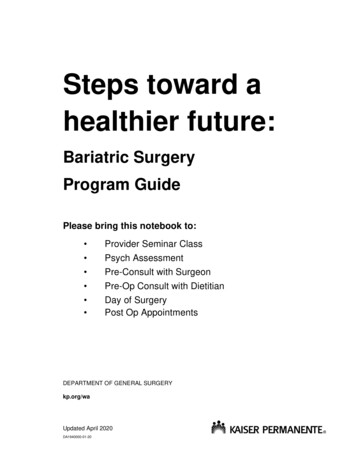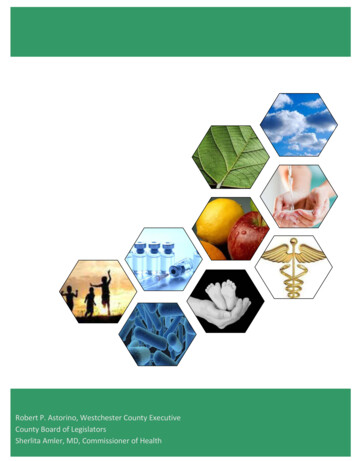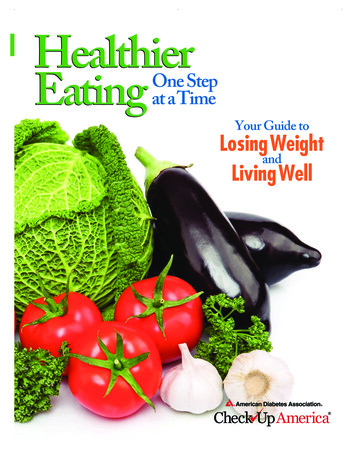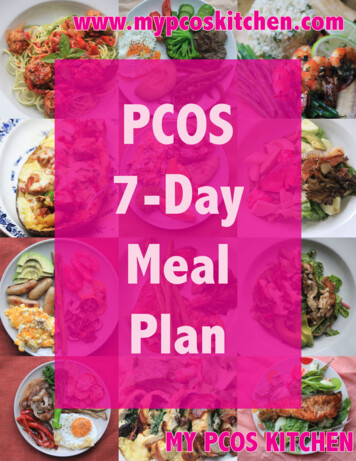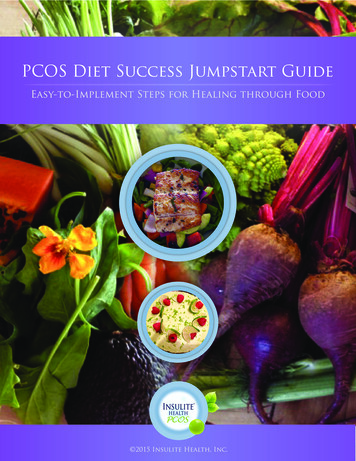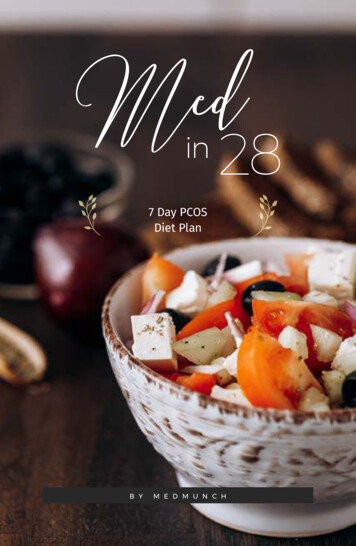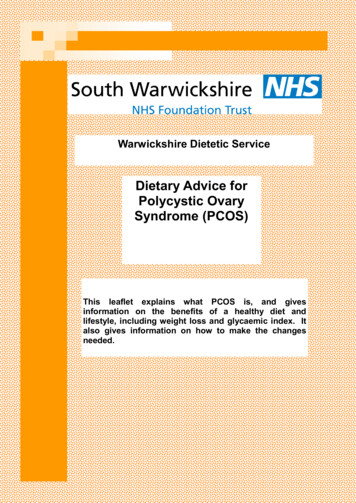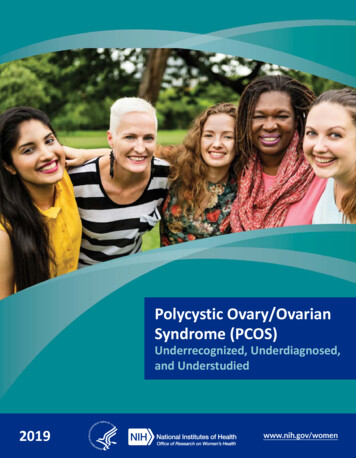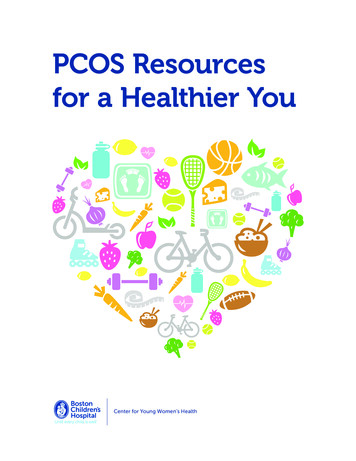
Transcription
PCOS Resourcesfor a Healthier YouCenter for Young Women’s Health
IN APPRECIATIONThe staff of the Center for Young Women’s Health gratefully acknowledges theBoston Children’s Hospital League, the Cabot Family Charitable Trust, and theOffice of Women’s Health for funding this project over the past decade.We are thankful to the dedicated team of authors: Phaedra Thomas RN, BSN, KendrinSonneville ScD, RD, LDN, and Katrina Schroeder, RD, LDN. Special thanks to AmandaKohn, BFA for designing this book, and to Anna Miller, BA for making additions andupdates to this book.The team is especially grateful to S. Jean Emans, MD for her guidance and edits, butmost of all for her committment to improving the lives of young women with PCOS. Center for Young Women’s Health Boston Children's HospitalLast updated June 1, 2016
PCOS Resourcesfor a Healthier YouInside this booklet you’ll find information on what causes PCOS and ways totreat it, a list of the top 10 PCOS tips, healthy ways to manage your weight, medicationand period trackers, fitness worksheets, and a glossary to help you understandPCOS–related medical terms.HOW TO USE THIS RESOURCE BOOKLET:Finding information is easy—just check out the Table of Contents on the next page.Each topic is listed along with a brief description. We suggest reading the generalguide about PCOS first, so you will have a good understanding of exactly what PCOSis and how it affects your body. Then check out the other topics, and be sure to takeadvantage of the helpful worksheets. Also, don’t forget to try some of the deliciousPCOS–friendly recipes.By learning about PCOS, you're taking a very important step in caring for yourhealth. Good luck and happy reading.
Table of ContentsPOLYCYSTIC OVARY SYNDROME (PCOS): An introduction to PCOS in teens1that answers the most commonly asked questions about symptoms, causes, andavailable treatments.PREPARING FOR YOUR ORAL GLUCOSE TOLERANCE TEST (OGTT):9An explanation of what an OGTT is and how to get ready for it.MY PERIOD TRACKERS: Worksheets that will help you keep track of when your15period starts and stops to see if there's a pattern to your menstrual cycle.THE ORAL CONTRACEPTIVE PILL & PCOS: A guide about the benefits and21possible side effects of the oral contraceptive pill.TAKING THE ORAL CONTRACEPTIVE PILL: Easy to read instructions on how to25take the oral contraceptive pill, complete with illustrations.THE ORAL CONTRACEPTIVE PILL & PCOS FAQ'S: A collection of frequently27asked questions and answers about oral contraceptive pills.INSULIN, METFORMIN, AND PCOS: A guide about the relationship between31insulin and PCOS, including information about the medication Metformin.SPIRONOLACTONE & PCOS: A guide about the the medication Spironolactone.35MY MEDICATION LIST: A worksheet that will help you keep track of37your medications.PCOS NUTRITION BASICS: An introduction to PCOS–friendly eating.39THE NUTRITION FACTS LABEL: A simple explanation of the Nutrition Facts label43and how to read it.PCOS GUIDE TO GROCERY SHOPPING: Tips on how to make healthy choiceswhen food shopping.47
PCOS–FRIENDLY FOODS AND SNACKS: A list of PCOS–friendly foods and snacks49that are good sources of protein, high–fiber carbohydrates, and healthy fats.SAMPLE MENUS: Three sample menus that will help give you some ideas for healthy53meals and snacks.MY MENU: A blank menu that you can fill in with your own ideas for PCOS–friendly55meals and snacks.PCOS–FRIENDLY RECIPES: Eleven healthy and delicious recipes (complete withNutrition Facts labels) for you to include in your PCOS–friendly eating plan.PCOS MEAL ASSESSMENT WORKSHEET: A worksheet that makes it easy to log what5965you eat and helps you think about whether you made PCOS–friendly choices in your mealsand snacks.FITNESS PLAN WORKSHEETS: Three worksheets that will help you figure out what67motivates you to exercise, what activities you’ll enjoy most, and how to create yourown fitness plan.GLOSSARY: A collection of PCOS–related terms that are used throughout this73resource book.ADDITIONAL PCOS RESOURCES: A collection of recommended resourcesincluding chats, websites, and books about PCOS.77
Polycystic OvarySyndrome (PCOS)PCOS is a common problem among teen girls and young women. In fact, almost 1out of 10 women has PCOS.What is PCOS?Polycystic ovary syndrome (PCOS) is a hormone imbalance that can cause irregularperiods, unwanted hair growth, and acne. PCOS begins during a girl’s teen years andcan be mild to severe.What are the signs of PCOS?Some of the most common signs of PCOS include: Irregular periods that come every few months, not at all, or too frequently Extra hair on the face or other parts of the body, called hirsutism Acne Weight gain and/or trouble losing weight Patches of dark skin on the back of the neck and other areas, called acanthosisnigricans (a–can–tho–sis ni–gri–cans)Could I have PCOS?If you have some or all of the above signs, you might have PCOS. There can beother reasons why you might have signs; however, only your health care providercan tell for sure.What causes PCOS?PCOS is caused by an imbalance in the hormones (chemical messengers) in your1
brain and your ovaries. PCOS usually happens when a hormone called LH (from thepituitary gland) or levels of insulin (from the pancreas) are too high, which then causesthe ovaries to make extra amounts of testosterone.For a more detailed explanation, take a look at the figure below:BrainThyroid GlandParathyroidGlandsPituitary Gland(located at the base of thebrain, sends LH and FSH tothe ovaries)Adrenal GlandsKidneysPancreasUterusVaginaOvaries (make estrogen, progesterone,and testosterone)1. The pituitary (pi–tu–i–tary) gland in your brain makes the hormones luteinizing(lu–tin–iz–ing) hormone (LH) and follicle (fall–i–call) stimulating hormone (FSH).2. After getting the signal from the hormones LH and FSH, the ovaries make estrogen(es–tro–gen) and progesterone (pro–ges–ter–own), the female sex hormones.3. All normal ovaries also make a little bit of the androgen testosterone (an–dro–gentes–tos–ter–own), a male sex hormone. The pancreas (pang–cree–us) is an organthat makes insulin. High levels of insulin can also cause the ovaries to make more ofthe hormone testosterone.Why are my periods so irregular?Having PCOS means that your ovaries aren't getting the right (hormonal) signals fromyour pituitary gland. Without these signals, you will not ovulate (make eggs) everymonth. Your period may be irregular, or you may not have a period at all.2
Let's review a regular menstrual cycle.1. The menstrual cycle starts when the brain sends LH and FSH to the ovaries. A bigsurge of LH is the signal that causes the ovaries to ovulate, or release an egg.2. The egg travels down the fallopian tube and into the uterus. Progesterone from theovary causes the lining of the uterus to thicken.3. If the egg isn't fertilized, the lining of the uterus is shed. This is a menstrual period.4. After the menstrual period, the cycle begins all over again.The diagram on top shows a regular menstrual cycle, and the diagram on the bottomshows a PCOS cycle with no ovulation.REGULAR MENSTRUAL CYCLEFollicles inthe OvaryPituitaryHormonesFSHLHCycle DayPCOS CYCLEFollicles inthe OvaryPituitaryHormonesLHFSHCycle Day3
Now, let's look at what happens during a menstrual cycle with PCOS.1. With PCOS, LH levels are often high when the menstrual cycle starts. The levels ofLH are also higher than FSH levels.2. Because the LH levels are already quite high, there is no LH surge. Without this LHsurge, ovulation does not occur, and periods are irregular.Girls with PCOS may ovulate occasionally or not at all, so periods may be too closetogether, or more commonly too far apart. Some girls may not get a period at all.What types of tests will my health care provider do to diagnose PCOS?Your health care provider will ask you a lot of questions about your menstrual cycleand your general health, and then do a complete physical examination. You will mostlikely need to have a blood test to check your hormone levels, blood sugar, andlipids (including cholesterol). Your health care provider may also want you to havean ultrasound test. This is a test that uses sound waves to make a picture of yourreproductive organs (ovaries and uterus) and bladder (where your urine is stored). Ingirls with PCOS, the ovaries may be slightly larger (often 10cc in volume) and havemultiple tiny cysts.Does PCOS mean I have cysts on my ovaries?The term "polycystic ovaries" means that there are lots of tiny cysts, or bumps,inside of the ovaries. Some young women with PCOS have these cysts; others onlyhave a few. Even if you do have lots of them, they're not harmful and they don't needto be removed.Why do I get acne and/or extra hair on my body?Acne and extra hair on your face and body can happen if your body is making toomuch testosterone. All women make testosterone, but if you have PCOS, your ovariesmake a little bit more testosterone than they are supposed to. Skin cells and hairfollicles can be extremely sensitive to the small increases in testosterone found inyoung women with PCOS.Why do I have patches of dark skin?Many adolescents with PCOS have higher levels of insulin in their blood. Higher levelsof insulin can sometimes cause patches of darkened skin on the back of your neck,under your arms, and in your groin area (inside upper thighs).4
Will PCOS affect my ability to have children some day?Women with PCOS have a normal uterus and healthy eggs. Many women with PCOShave trouble getting pregnant, but some women have no trouble at all. If you'reconcerned about your fertility (ability to get pregnant) in the future, talk to your healthcare provider about all the new options available, including medications to lower yourinsulin levels or to help you ovulate each month.What can I do about having PCOS?The most important treatment for PCOS is working towards a healthy lifestyle thatincludes healthy eating and daily exercise. There are also excellent medications tohelp you manage irregular periods, hair growth, and acne. Ask your health careprovider about the various treatment options.What is the treatment for PCOS?The most common form of treatment for PCOS is the oral contraceptive pill; however,other kinds of hormonal therapy may include the vaginal ring and the patch. Even ifyou're not sexually active, birth control pills may be prescribed because they containthe hormones that your body needs to treat your PCOS. Birth control pills (eithertaken continuously or in cycles) can: Correct the hormone imbalance Lower the level of testosterone (which will improve acne and lessen hair growth) Regulate your menstrual periods Prevent an unplanned pregnancy if you are sexually activeIs there any other medicine to treat PCOS?A medicine which helps the body lower the insulin level is called Metformin. It'sparticularly helpful in girls who have high levels of insulin, or have pre–diabetes ordiabetes. Some girls are treated with both Metformin and birth control pills at thesame time.Ask your health care provider about treating hair growth. Only you and your healthcare provider can decide which treatment is right for you. Options may includebleaching, waxing, depilatories, spironolactone (spi–ro–no–lac–tone), electrolysis,and laser treatment. Spironolactone is a prescription medicine that can lessen hair5
growth and make hair lighter and finer. However, it can take up to 6–8 months to seean improvement.Ask your health care provider about treatment for acne. There are various waysto treat acne, including the birth control pill, topical creams, oral antibiotics, andother medications.Ask your health care provider about a weight loss plan if you are overweight.If you're overweight, losing weight may lessen some of the symptoms of PCOS.Talk to your health care provider or nutritionist about healthy ways to lose weightsuch as exercising more and following a nutrition plan that helps manage insulinlevels. Healthy eating can also keep your heart healthy and lower your risk ofdeveloping diabetes.Weight Management Tips: Choose nutritious, high–fiber carbohydrates instead of sugary orrefined carbohydrates Balance carbohydrates with protein and healthy fats Eat small meals and healthy snacks throughout the day instead of large meals Exercise regularly to help manage insulin levels and your weightWhat if I have worries about having PCOS?If you've been told you have PCOS, you may feel frustrated or sad. You may also feelrelieved that at last there is a reason and treatment for the problems you have beenhaving, especially if you have had a hard time managing your weight, or you haveexcess body hair, acne, or irregular periods. Having a diagnosis without an easy curecan be difficult. However, it's important for girls with PCOS to know they are notalone. Finding a health care provider who knows a lot about PCOS and is someoneyou feel comfortable talking to is very important. Keeping a positive attitude andworking on a healthy lifestyle even when results seem to take a long time is veryimportant, too! Many girls with PCOS tell us that talking with a counselor about theirconcerns can be very helpful. Other girls recommend online chats. The Center forYoung Women's Health offers a free and confidential monthly chat for girls and youngwomen with PCOS, moderated by a registered nurse and dietitian.6
What else do I need to know?It's important to follow–up regularly with your health care provider and make sure youtake all the medications prescribed to regulate your periods and lessen your chanceof getting diabetes or other health problems. Because you have a slightly higherchance of developing diabetes, your health care provider may suggest that you haveyour blood sugar tested once a year, or have a glucose challenge test every few years,especially if you are overweight. Quitting smoking (or never starting) will also improveyour overall health. Because you have a higher chance of developing diabetes, yourhealth care provider may suggest having a: Blood sugar test once a year A1C test (a test that tells how high your blood sugar has been the past 2–3 months)once a year Glucose tolerance test every few yearsPCOS TIP: Eat a balanced diet. Your body needs carbohydrates, protein,and fat.7
Preparing for Your OralGlucose Tolerance Test(OGTT)If you have PCOS and you’re getting ready to have an oral glucose tolerance test,you may be wondering how to prepare for the test and what the results may mean.The test can help your health care provider figure out whether you have a highrisk of developing diabetes and whether lifestyle changes and medications such asMetformin might be helpful in treating your PCOS.What is Glucose?Glucose is a type of sugar and the main source of energy used by your body.The glucose that your body uses for energy comes from many kinds of foods calledcarbohydrates, such as; cereal, bread, rice, pasta, and other grains, not just sugaryfoods. Dairy products, fruits, and vegetables all contain carbohydrates, as well. Yourbody uses the glucose it needs and then stores the rest as "glycogen" in your liver andmuscles.What is an Oral Glucose Tolerance Test (OGTT)?An OGTT is a way to measure your body’s ability to use glucose. Your pancreas(a gland located behind the stomach) makes a hormone called insulin, which helpsyour body use the glucose in your blood. If your pancreas doesn't make enoughinsulin or if your body is unable to use the insulin it makes, you may have a highblood glucose level. The OGTT involves fasting overnight and then having your bloodchecked early in the morning. You will then drink a special glucose drink and haveyour blood tested again after 2 hours. Sometimes blood sugar levels are also checkedat other times such as 1 hour, 3 hours, or 4 hours after the glucose drink.9
What if my blood glucose level is high?If the OGTT shows that your blood glucose levels are higher than normal, your healthcare provider may tell you that you have "impaired glucose tolerance". This oftenmeans that you are at risk for developing diabetes. Rarely, diabetes is diagnosed afteran OGTT. Diabetes is an illness that can develop if your body does not make enoughinsulin, or when your body has trouble using the insulin that it does make.Your health care provider may suggest a fasting glucose level, an A1C, or an oralglucose test (especially if you are overweight). Depending on the results, these testsare often repeated every few years.What do I need to do before the OGTT?Your health care provider will most likely give you either a glucose drink to take homeor a prescription to bring to your pharmacy or the lab. Some tests are done in a healthcare provider’s office, but most often the test is done in a lab at a hospital or clinic.The test takes several hours (most of it is waiting between blood tests), so you'll needto plan on being at the lab or your HCP's office for most of the morning. If you needto fill a prescription, be sure you call your pharmacy ahead of time to see if they havethe glucose drink in stock, because some pharmacies may not carry this item, or theymay need to order it.Do I need to eat anything special before the test?3 DAYS BEFORE THE OGTT:Plan on eating three healthy meals and snacks for 3 days before the test. You do notneed to buy special food, but you do need to make sure you have healthy foods toeat. Your meals should be balanced with plenty of carbohydrates.Foods containing carbohydrates include: Fruits Breads Cereal Pasta Rice Crackers Starchy vegetables (corn/peas/carrots)10
12 HOURS BEFORE THE OGTT:DO NOT eat, smoke, or do heavy exercise 12 hours before the test. (For example:If your test is scheduled for first thing in the morning, ie: at 8 AM—Do not eat,smoke, or do heavy exercise after 8pm the night before). You may drink plain,NOT flavored, water.What happens on the morning of the test?When you are ready to leave your home to have your test done, be sure to rememberto bring: Your laboratory slips Your glucose drink (unless the lab provides it) Reading material/book/magazine (optional) Earbud headphones if you want to listen to music while you're waiting (optional)VERY IMPORTANT! DO NOT DRINK the glucose drink until you arrive at the lab.The lab technician will tell you when to drink the glucose drink.AT THE LAB:First: A fasting blood glucose test is done. This is a simple blood test that checks yourblood sugar before you drink the glucose drink.Next: The lab technician will tell you to drink the glucose drink. It will taste very sweet.It's important to drink the whole amount fairly quickly.Waiting: After you finish drinking all of the glucose drink, you'll be asked to sit until it'stime for your next blood test (about 2 hours later). You may read, listen to music, talk,or do another quiet activity while you are waiting.VERY IMPORTANT! DO NOT EAT or DRINK anything except plain water whileyou're waiting.11
AFTER THE OGTT:Once your tests are done and the lab technician gives you permission to leave, youmay go about your normal daily activities. You can go back to school or work, eat,drink, and do the regular exercise that you normally do.When can I expect to get my test results?The lab will usually send your results to your health care provider within afew days. You may already have a follow–up appointment scheduled or yourhealth care provider may call you to review your results and let you know if thereare any concerns.What do the results mean?The first test or "baseline" glucose test is your blood glucose level before you drankthe glucose drink. Normal fasting blood glucose levels are less than 100 mg/dl. Yourhealth care provider may also check your insulin level. A high level of insulin meansthat your body does not use insulin well (even if your glucose levels are normal).The second result of your 2–hour blood glucose test measures your glucose twohours after you drank the glucose drink. This level should be less than 140mg/dl.Normal levels of glucose mean that your body is able to use glucose the way it'ssupposed to.High levels of glucose mean that you have impaired glucose tolerance (IGT). Thismeans that your body has a hard time using glucose, and puts you at risk fordeveloping diabetes. If your glucose levels continue to be very high, it could meanthat you have diabetes.What is the connection between impaired glucose tolerance (IGT) and PCOS?Health care providers have known for some time that many of the symptoms ofPCOS are caused by too much of the hormone testosterone. With PCOS, the ovariesmake too much of this hormone which can result in extra facial and body hair andmenstrual problems. Many young women with PCOS also have high levels of insulinthat can stimulate the ovaries to make testosterone. The high levels of insulin alsoincrease the chance of getting diabetes. Your HCP will look at your OGTT resultsalong with other test results to figure out the best treatment for you includingexercise, weight loss (if you're overweight), and sometimes, medication.12
Understanding how to prepare for an OGTT test and what the results mean can helpyou take charge of your PCOS. Making healthy food choices, exercising, and talkingabout your medication options with your health care provider are the best ways tokeep your body healthy.PCOS TIP: Choose healthy carbohydrate foods that are high in fiber and lowin sugar.13
My Period TrackersWhy should I track of my period?Keeping track of when your period starts and stops is a good way to see if there is apattern to your menstrual cycle. It's also important to write down how many days youhave your period and the amount of flow you have. Make a photocopy of the PeriodTracker and bring your it with you when you see your health care provider so that heor she can evaluate your cycle.My Monthly Period & Symptom TrackerMy Monthly Period & Symptom Tracker is an easy way to keep track of your menstrualflow, and it’s also a way to keep track of cramps, and/or PMS and period symptoms (ifyou have them) each month. Review the sample Monthly Period & Symptom Tracker. Make copies of My Monthly Period & Symptom Tracker. Simply make a check mark in the appropriate box (or boxes) for each day of themonth. If you don't have any flow or any symptoms on any given day, leave the boxempty. Refer to the Blood Flow Key at the bottom for "Flow" definitions. The numbers at the top are the same as the dates in one month. Some monthsdon't have 31 days, so you may leave some boxes empty. Remember to bring My Monthly Period & Symptom Tracker with you to yourmedical appointments.My Yearly Period TrackerMy Yearly Period Tracker is a simple and convenient way to track your periodthroughout the year. Review the sample Yearly Period Tracker. Make copy of My Yearly Period Tracker.15
Refer to the Key at the bottom to learn how to fill in the box with the appropriateletter(s). Place a "T" in the box for the hormone pill taken, and place an "R" forreminder (placebo) pills. Be sure to note if you've taken a pill during your period by putting a B/T or B/R inthe box. Remember to bring My Yearly Period Tracker to your medical appointments. Talk to your health care provider about whether you should use the monthly and/oryearly tracker to track your period.16
4567833Heavy: more than 6 tampons or pads/dayNormal: 4–6 tampons or pads/dayLight: 1–3 tampons or pads/dayMONTH: January33 310 11 12 13 14 15 16 17 18 19 20 21 22 23 24 25 26 27 28 29 30 313 39Blood flow key: Spotting: tiny amount of flow on your underwear or panty shieldvomitingnauseadizzinessdiarrheacrampsperiod symptomsirritabilitymood swingsbreast sorenesscrying3 33bloating231acne (break out)pms symptomsheavynormallightspottingblood flowdateSAMPLE MONTHLY PERIOD & SYMPTOM TRACKER
123456789Heavy: more than 6 tampons or pads/dayNormal: 4–6 tampons or pads/dayLight: 1–3 tampons or pads/dayMONTH:10 11 12 13 14 15 16 17 18 19 20 21 22 23 24 25 26 27 28 29 30 31Blood flow key: Spotting: tiny amount of flow on your underwear or panty shieldvomitingnauseadizzinessdiarrheacrampsperiod symptomsirritabilitymood swingsbreast sorenesscryingbloatingacne (break out)pms symptomsheavynormallightspottingblood flowdateMY MONTHLY PERIOD & SYMPTOM TRACKER
Key:YEAR: 2016T T T T T T T T T T T T T T T T T T T R RT hormone pill takenR reminder (placebo) pill takenS spottingB bleedingB B B B/R /R /R /R R T T T T T1 2 3 4 5 6 7 8 9 10 11 12 13 14 15 16 17 18 19 20 21 22 23 24 25 26 27 28 29 30 31Enter appropriate letter in proper calendar day LE YEARLY PERIOD TRACKER
Key:YEAR:1 2 3 4 5 6 7 8 9 10 11 12 13 14 15 16 17 18 19 20 21 22 23 24 25 26 27 28 29 30 31T hormone pill takenR reminder (placebo) pill takenS spottingB bleedingEnter appropriate letter in proper calendar day square.decnovoctsepaugjuljunmayaprmarfebjandayMY YEARLY PERIOD TRACKER
The Oral ContraceptivePill & PCOSAdolescent girls and young women are frequently prescribed oral contraceptivepills (also called the "Pill") for Polycystic Ovary Syndrome and for irregular orabsent menstrual periods, menstrual cramps, acne, PMS, and endometriosis. Oralcontraceptive pills lower hormone levels in girls with PCOS and regulate theirmenstrual periods. Hormone patches (Ortho-Evra, Xulane) and vaginal hormone ring(NuvaRing) also help to lower the hormone levels in girls with PCOS.What are oral contraceptive pills?Oral contraceptive pills contain two types of synthetic female hormones, progestinand estrogen. Similar hormones are made by the ovaries. There are many differentkinds of oral contraceptive pills.What are some of the possible medical benefits of oral contraceptive pills foryoung women with PCOS? Regular and Lighter Periods: Oral contraceptive pills can help to regulate yourmenstrual cycle so your period comes about every 28 days or less often onextended pill cycles. The Pill usually causes lighter periods, too. Less Unwanted Hair: Oral contraceptive pills can lower androgen hormonelevels and lessen the amount of excess hair growth (also called "hirsutism"). It cantake 6 months before there's a decrease in unwanted hair on the face, chest, back,and stomach. Clearer Skin: Oral contraceptive pills can improve acne. The hormones in mosttypes of the Pill can help stop acne from forming. Be patient though, it can take afew months to see an improvement. Less or Milder Cramps, or No Cramps: Oral contraceptive pills can help to lessenmenstrual cramps.21
Other Medical Benefits: Because there is less menstrual bleeding with the use oforal contraceptive pills, girls taking the Pill are less likely to become anemic. Oralcontraceptive pills also decrease your chance of getting endometrial (lining of theuterus) cancer, ovarian cancer, and ovarian cysts.What are the possible side effects of the oral contraceptive pill?Most women have no side effects when taking the oral contraceptive pill, but it'spossible to have irregular periods, nausea, headaches, or weight change. Each type oforal contraceptive pill can affect a young woman differently. Spotting (you usually don’t need to use a regular pad, just a panty shield) or verylight bleeding: This may occur during the first 1–3 weeks of starting the Pill, or ifyou miss a pill. If the bleeding becomes heavier or lasts more than a few days or thebleeding happens after you have been on the pill for a few months, you should talkwith your health care provider. Nausea (or feeling like you need to throw up): Nausea occasionally occurs whenyou first start taking the Pill and will often go away in a few days. It is less likely tooccur if the Pill is taken after dinner or with a bedtime snack. Headaches: Headaches may occur because of stress at school or home, too littlesleep, sinus infections, or migraines. The Pill can make headaches better or worse.If your health care provider thinks your headaches are related to the Pill, he/she mayprescribe an oral contraceptive pill with a lower amount of estrogen or have you gooff the Pill for a short time. If you have migraine headaches, talk to your health careprovider about whether the Pill is right for you. Mood changes: Feeling up and down emotionally can sometimes happen toanyone and is unlikely to be caused by the Pill. Exercising regularly and following ahealthy diet may help along with talking to a counselor. Make sure you let yourhealth care provider know how you are feeling. Sore or enlarged breasts: Very occasionally, your breasts may become tender and/or get larger, but usually they will stay the same. Weight change: Some teens gain weight and some teens lose weight while on thePill, but most stay exactly the same. Remember to choose healthy foods, watchyour portion sizes, drink lots of water, and get plenty of exercise. Blood clots: A blood clot in your leg or lung is a very rare, but a serious side–effect.If you suddenly have pain or swelling in your leg, or shortness of breath and chest22
pain, see your health care provider right away. If you have a history of blood clots,you should not take the Pill. Tell your health care provider if any of your relativeshave ever had blood clots, especially when they were young. Blood clots are morelikely to develop if you are a smoker, overweight, having surgery, or sitting on aplane for a long time. To lessen your chance of blood clots, don't smoke, andif you're on a long plane trip, get up, walk around, and drink lots of water. If you'rescheduled for surgery, talk to your health care provider about stopping the Pill for3–4 weeks before surgery and after the surgery until you have recovered.If side effects from the Pill occur, they're usually mild and go away in the first three tofour cycles. If you do have side effects, talk with your health care provider. If the sideeffects are uncomfortable or if they don't go away, your health care
Jun 01, 2016 · PCOS–FRIENDLY RECIPES: Eleven healthy and delicious recipes (complete with Nutrition Facts labels) for you to include in your PCOS–friendly eating plan. PCOS MEAL ASSESSMENT WORKSHEET: A worksheet that makes it easy to log what you eat and helps you think about whether


